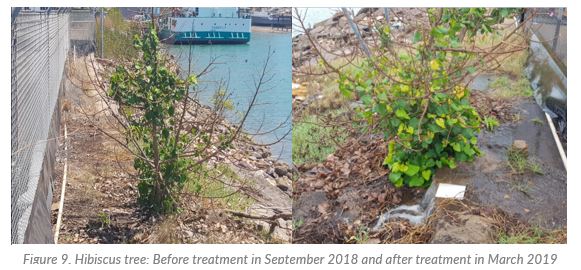You’ve heard of ant farms, but have you heard of farmer ants?
Browsing ants (Lepisiota frauenfeldi) are an exotic invasive species, ideally suited to Australian conditions. Browsing ants are considered to be a significant threat to our environment and economy. They form super-colonies, which reach very large numbers. Browsing ants can be observed on the ground as well as in trees, leaf litter and infrastructure, such as electrical boxes. They ‘farm’ and protect scale insects, which reduces plant vigour and can eventually kill the plants they live on. They eat and displace native ant species, as well as other insects, in the infested area.
National Browsing Ant Eradication Program (NBAEP) field staff observed the N.T. native tree commonly known as beach hibiscus (Hibiscus tiliaceus) suffering badly from the effects of Lepisiota fraunfeldi (browsing ants) farming Mealy bugs (family Pseudococcidae). Mealy bugs, aphids and other scale insects benefit from a symbiotic relationship with some ant species who harvest a sweet nectar called honeydew from the scale insects in return for protection from predators. This can lead to a proliferation of scale insects on the host plant. A high population of scale insects can negatively impact the host plant in many ways and in worst case scenarios lead to the death of the host plant. The beach hibiscus in question was thought to be beyond recovery and headed for this grizzly fate (see picture below).
However, after NBAEP field staff treated the infested site, the hibiscus made a remarkable recovery. It now has dozens of new shoots and a dense covering of new and healthy leaves. This is a great example of how the NBAEP has benefited native plant species suffering from the effects of this invasive tramp ant species.
Browsing ants are a slender ant, and are a consistent shiny dark brown in colour. They are 3–4mm in length with long antennae and long legs, and run about in a crazy or haphazard manner when disturbed.
Browsing ants were first detected in the NT in June 2015. Known infestations are limited to the suburbs of Berrimah, East Arm, Frances Bay and Wickham Point.
Browsing ants originate from Southern Europe and are commonly found in South East Asia including Timor Leste and Malaysia.
If you think you have seen a browsing ant population, please contact the Exotic Plant Pest Hotline on 1800 084 881.
Give feedback about this page.
Share this page:
URL copied!
